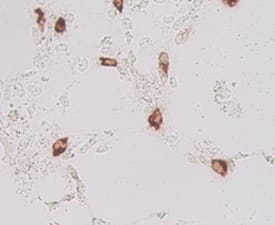Mouse Lgr5/GPR49 Antibody
R&D Systems, part of Bio-Techne | Catalog # MAB8240
Published as Clone RD20


Conjugate
Catalog #
Key Product Details
Species Reactivity
Validated:
Mouse
Cited:
Mouse, Transgenic Mouse
Applications
Validated:
Agonist Activity, CyTOF-ready, Flow Cytometry, Immunocytochemistry
Cited:
Flow Cytometry, Immunohistochemistry
Label
Unconjugated
Antibody Source
Monoclonal Rat IgG2B Clone # 803420
Product Specifications
Immunogen
E. coli-derived recombinant mouse Lgr5/GPR49
Lys375-Pro547
Accession # Q9Z1P4
Lys375-Pro547
Accession # Q9Z1P4
Specificity
Detects mouse Lgr5/GPR49 in ELISA. Stains mouse Lgr5 transfected cells but not irrelevant transfectants in Flow Cytometry and Immunocytochemistry. This antibody, also known as "RD20", has been found to detect an epitope in C-terminal LRR cap of LGR5 (Ref. 1).
Clonality
Monoclonal
Host
Rat
Isotype
IgG2B
Scientific Data Images for Mouse Lgr5/GPR49 Antibody
Detection of Lgr5/GPR49 in HEK293 Human Cell Line Transfected with Mouse Lgr5/GPR49 and eGFP by Flow Cytometry.
HEK293 human embryonic kidney cell line transfected with mouse Lgr5/GPR49 and eGFP was stained with and either (A) Rat Anti-Mouse Lgr5/GPR49 Monoclonal Antibody (Catalog # MAB8240) or (B) Rat IgG2BIsotype Control (Catalog # MAB0061) followed by Allophycocyanin-conjugated Anti-Rat IgG Secondary Antibody (Catalog # F0113).Lgr5/GPR49 in HEK293 Human Cell Line Transfected with Mouse Lgf5/GPR49.
Lgr5/GPR49 was detected in immersion fixed HEK293 human embryonic kidney cell line transfected with GFP (green) tagged mouse LGR5 using Rat Anti-Mouse Lgr5/GPR49 Monoclonal Antibody (Catalog # MAB8240) at 10 µg/mL for 3 hours at room temperature. Cells were stained using the NorthernLights™ 557-conjugated Anti-Rat IgG Secondary Antibody (red; Catalog # NL013) and counterstained with DAPI (blue). Specific staining was localized to cell surfaces and cytoplasm. View our protocol for Fluorescent ICC Staining of Cells on Coverslips.Lgr5/GPR49 in Mouse Cells Transfected with Mouse Lgr5/GPR49.
Lgr5/GPR49 was detected in immersion fixed MYC tagged mouse transfectants using Rat Anti-Mouse Lgr5/GPR49 Monoclonal Antibody (Catalog # MAB8240). Cells were stained using an anti-Mouse HRP-conjugated secondary antibody (brown).Image courtesy of Dr. Hans Clevers, Hubrecht Institute, The Netherlands.Applications for Mouse Lgr5/GPR49 Antibody
Application
Recommended Usage
Agonist Activity
Peng, W.C., et al. (2013) Cell Reports. 3:1885.
CyTOF-ready
Ready to be labeled using established conjugation methods. No BSA or other carrier proteins that could interfere with conjugation.
Flow Cytometry
2.5 µg/106 cells
Sample: HEK293 human embryonic kidney cell line transfected with mouse Lgr5/GPR49 and eGFP
Sample: HEK293 human embryonic kidney cell line transfected with mouse Lgr5/GPR49 and eGFP
Immunocytochemistry
8-25 µg/mL
Sample: Immersion fixed HEK293 human embryonic kidney cell line transfected with GFP tagged mouse LGR5
Sample: Immersion fixed HEK293 human embryonic kidney cell line transfected with GFP tagged mouse LGR5
Formulation, Preparation, and Storage
Purification
Protein A or G purified from hybridoma culture supernatant
Reconstitution
Reconstitute at 0.5 mg/mL in sterile PBS. For liquid material, refer to CoA for concentration.
Formulation
Lyophilized from a 0.2 μm filtered solution in PBS with Trehalose. *Small pack size (SP) is supplied either lyophilized or as a 0.2 µm filtered solution in PBS.
Shipping
Lyophilized product is shipped at ambient temperature. Liquid small pack size (-SP) is shipped with polar packs. Upon receipt, store immediately at the temperature recommended below.
Stability & Storage
Use a manual defrost freezer and avoid repeated freeze-thaw cycles.
- 12 months from date of receipt, -20 to -70 °C as supplied.
- 1 month, 2 to 8 °C under sterile conditions after reconstitution.
- 6 months, -20 to -70 °C under sterile conditions after reconstitution.
Background: Lgr5/GPR49
References
- Peng et al. (2013) Cell Rep. 3(6):1885.
- de Lau et al. (2014) Genes Dev. 28(4):305.
- Barker et al. (2013) Development 140(12):2484.
- Clevers (2013) Nature 495(7439):53.
- Wu et al. (2014) Nat Commun 5:3149.
- Jang et al. (2013) PLoS One 8(12):e82390495.
Long Name
Leucine-rich Repeat Containing G Protein-coupled Receptor 5
Alternate Names
FEX, GPR49, GPR67, HG38
Gene Symbol
LGR5
UniProt
Additional Lgr5/GPR49 Products
Product Documents for Mouse Lgr5/GPR49 Antibody
Product Specific Notices for Mouse Lgr5/GPR49 Antibody
For research use only
